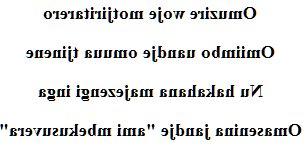Otjiherero love poem
Motjiritarero
Omuzire woje motjiritarero
Omiimbo uandje omuua tjinene
Nu hakahana majezengi inga
Omasenina jandje "ami mbekusuvera"


→ French poem ←
Otjiherero language
Love poem translated into the Otjiherero (other names with dialect names : Herero, Otjihakaona, Otjikuvare, Otjimbanderu, Oluthimba, Mbandieru, Otjitwa, Olungambwe, Ochiherero, Helelo, Otjingumbi, Ovaherero), a language of Namibia (Hereroland), Botswana and Angola.
This Bantu language is spoken by the Herero people. They will be 150,000 to be able to understand my little poem, mainly in Namibia.
These Herero-speaking regions (Kaokoland, Eastern Hereroland and Western Hereroland, Omaruru and Aminuis Reserve), plus those of Bostwana and Angola, are mostly rural.
Otjiherero is a national language of Namibia, it is a language used in schools, administration and the media.
We could distinguish four groups of Hereros with four dialects: those of the center (Kaokolanders), the east (Ovambanderu) and the north-west (Kaokoveld) of Namibia and those of Botswana.
The central dialect is the one called herero. If the Eastern Otjimbanderu dialect, was certainly different in the past, with the standardization on the central dialect, and its teaching in schools and at the university, it comes very close today.
In Kakoland there are at least eight gopus who speak Herero: the Herero, Tjimba-Herero, Himba, Ndamuranda, Hakaona, Zemba, Tjimba and Thwa. Groups that the Herero encountered during their migration, groups that somehow merged with them and adopted their language and culture.
The Hereros
According to oral traditions, the Ovaherero, Bantu of the southwest, would have migrated from the great lakes to Namibia, stopping in Angola, where Tjimba were, a hundred years old.
They revolted in 1896 and 1904, and were decimated by the Germans, which provoked Erzberger's opposition and the government coalition break-up. It's about two centuries after the Ovambo and the Kavango, that the Herero came in the South West Africa. Coming from the Mossamedes region in Angola in the 18th century, they clashed with the Ovambo in the north. Because of the fierce resistance of the natives, they descended further south, where their homeland is now. Some even reached the Bechuanaland where they are known as Mbanderu.
The Herero are pastors, whose whole life is determined by the search for pastures, so, after remaining in Kaokoland, their nomadic life moved them further south to Omaruru, Otjomuise (Windhoek), and all the places in Herero country where they are found today.
This nomadic people, who live mainly from breeding, did not have a political structure accompanied by a supreme leader. Many leaders, holding their powers by the possession of the sacred fire and imposing flocks, competed with each other. Warlike people, the Herero, subdued the Dama and clashed victoriously with the Nama. Then they underwent the external influence of the German missionaries, who came to convert them to Christianity. A persistent sign of this imprint lies in the clothes worn by the women, modeled on those of the wives of the missionaries.
After missionaries came the German colonization. In 1885, the first Reichcommissar of South West Africa is named; his name is Dr. Heinrich Göring, father of the future Nazi dignitary. In 1904, the Hereros led by their chief Maharero took up the arms against their colonizers and attacked Okahandja on January 11, massacring all Europeans. The German retort which followed, decimated them. These revolts and pacifications were heavy in human lives (12 to 65,000 Herero, 6,000 Nama, 1,500 German).